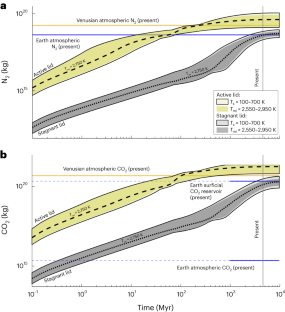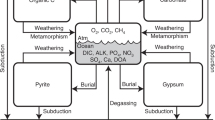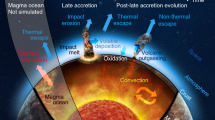Abstract
Venus is the least understood of the terrestrial planets. Despite broad similarities to the Earth in mass and size, Venus has no evidence of plate tectonics recorded on its young surface, and Venus’s atmosphere is strikingly different. Numerical experiments of long-term planetary evolution have sought to understand Venus’s thermal–tectonic history with indeterminate results. However, Venus’s atmosphere is linked to interior evolution and can be used as a diagnostic to constrain planetary evolution. Here we compare the present-day Venusian atmosphere to atmospheres generated by long-term thermal–chemical–tectonic evolution models. We find that a continuous single-plate stagnant lid regime operating since antiquity (magma ocean solidification) explains neither the present-day observed atmospheric abundances of N2 and CO2, nor the surface pressure. Instead, the Venusian atmosphere requires volcanic outgassing in an early phase of plate-tectonic-like activity. Our findings indicate that Venus’s atmosphere results from a great climatic–tectonic transition, from an early phase of active lid tectonics that lasted for at least 1 Gyr, followed by the current stagnant lid-like mode of reduced outgassing rates.
This is a preview of subscription content, access via your institution
Access options
Access Nature and 54 other Nature Portfolio journals
Get Nature+, our best-value online-access subscription
$29.99 / 30 days
cancel any time
Subscribe to this journal
Receive 12 digital issues and online access to articles
$119.00 per year
only $9.92 per issue
Buy this article
- Purchase on Springer Link
- Instant access to full article PDF
Prices may be subject to local taxes which are calculated during checkout




Similar content being viewed by others
Data availability
Data used to generate Figs. 1–4 are available at https://doi.org/10.5281/zenodo.7570178.
Code availability
MATLAB is a commercial code. The C parametrized thermal evolution code used here and described in the Methods sections, in addition to the MATLAB analysis code(s), are available from the authors upon reasonable request.
References
Bullock, M. A. & Grinspoon, D. H. The recent evolution of climate on Venus. Icarus 150, 19–37 (2001).
Schaber, G. G. et al. Geology and distribution of impact craters on Venus: what are they telling us? J. Geophys. Res. 97, 13257–13301 (1992).
Strom, R. G., Schaber, G. G. & Dawson, D. D. The global resurfacing of Venus. J. Geophys. Res. Planets 99, 10899–10926 (1994).
Way, M. J. et al. Was Venus the first habitable world of our solar system? Geophys. Res. Lett. 43, 8376–8383 (2016).
Weller, M. B. & Kiefer, W. S. The physics of changing tectonic regimes: Implications for the temporal evolution of mantle convection and the thermal history of Venus. J. Geophys. Res. Planets 125, e2019JE005960 (2020).
Gillmann, C. et al. Dry late accretion inferred from Venus’s coupled atmosphere and internal evolution. Nat. Geosci. 13, 265 (2020).
Gillmann, C. & Tackley, P. Atmosphere/mantle coupling and feedbacks on Venus. J. Geophys. Res. Planets 119, 1189–1217 (2014).
Way, M. J. & Del Genio, A. D. Venusian habitable climate scenarios: modeling Venus through time and applications to slowly rotating Venus-like exoplanets. J. Geophys. Res. 125, e2019JE006276 (2020).
Solomon, S. C. et al. Venus tectonics - An overview of Magellan observations. J. Geophys. Res. Planets 97, 13199–13255 (1992).
Phillips, R. J., Bullock, M. A. & Hauck, S. A. Climate and interior coupled evolution on Venus. Geophys. Res. Lett. 28, 1779–1782 (2001).
McGill, G. E. Venus tectonics: another Earth or another Mars? Geophys. Res. Lett. 6, 739–741 (1979).
Kaula, W. M. & Phillips, R. J. Quantitative tests for plate tectonics on Venus. Geophys. Res. Lett. 8, 1187–1190 (1981).
Schubert, G., Turcotte, D. L. & Olson, P. Mantle Convection in the Earth and Planets (Cambridge Univ. Press, 2001).
Cann, J. R. et al. A review of melt migration processes in the adiabatically upwelling mantle beneath oceanic spreading ridges. Philos. Trans. R. Soc. A. 355, 283–318 (1997).
Nimmo, F. & Stevenson, D. J. Influence of early plate tectonics on the thermal evolution and magnetic field of Mars. J. Geophys. Res. Planets 105, 11969–11979 (2000).
Guimond, C. M., Noack, L., Ortenzi, G. & Sohl, F. Low volcanic outgassing rates for a stagnant lid archean Earth with graphite-saturated magmas. Phys. Earth Planet. Inter. 320, 106788 (2021).
Noack, L., Rivoldini, A. & Van Hoolst, T. Volcanism and outgassing of stagnant-lid planets: Implications for the habitable zone. Phys. Earth Planet. Inter. 269, 40–57 (2017).
Som, S. M. et al. Earth’s air pressure 2.7 billion years ago constrained to less than half of modern levels. Nat. Geosci. 9, 448–451 (2016).
Stüeken, E. E. et al. Mission to planet Earth: the first two billion years. Space Sci. Rev. 216, 31 (2020).
Marty, B. The origins and concentrations of water, carbon, nitrogen and noble gases on Earth. Earth Planet. Sci. Lett. 313, 56–66 (2012).
Boujibar, A., Driscoll, P. & Fei, Y. Super-earth internal structures and initial thermal states. J. Geophys. Res. 125, e2019JE006124 (2020).
Taylor, F. & Grinspoon, D. Climate evolution of Venus. J. Geophys. Res. https://doi.org/10.1029/2008JE003316 (2009).
Breuer, D. & Moore, W. B. in Treatise on Geophysics (ed. Gerald Schubert) 299–348 (Elsevier, 2007).
Warren, A. O. & Kite, E. S. Narrow range of early habitable Venus scenarios permitted by modeling of oxygen loss and radiogenic argon degassing. Proc. Natl Acad. Sci. 120, e2209751120 (2023).
Walker, J. C. G., Hays, P. B. & Kasting, J. F. A negative feedback mechanism for the long-term stabilization of the Earth’s surface temperature. J. Geophys. Res. 86, 9776 (1981).
Rolf, T. et al. Dynamics and evolution of Venus’ mantle through time. Space Sci. Rev. 218, 70 (2022).
Solomatov, V. S. & Moresi, L. N. Stagnant lid convection on Venus. J. Geophys. Res. 101, 4737–4753 (1996).
Bjonnes, E., Johnson, B. C. & Evans, A. J. Estimating Venusian thermal conditions using multiring basin morphology. Nat. Astron 5, 498–502 (2021).
Zolotov, M. Y. Gas–solid interactions on venus and other solar system bodies. Rev. Mineral. Geochem. 84, 351–392 (2018).
Taylor, F. W., Svedhem, H. & Head, J. W. Venus: the atmosphere, climate, surface, interior and near-space environment of an Earth-like planet. Space Sci. Rev. https://doi.org/10.1007/s11214-018-0467-8 (2018).
Johnstone, C. P., Lammer, H., Kislyakova, K. G., Scherf, M. & Güdel, M. The young sun’s XUV-activity as a constraint for lower CO2-limits in the Earth’s archean atmosphere. Earth Planet. Sci. Lett. 576, 117197 (2021).
Weller, M. B., Lenardic, A. & O’Neill, C. The effects of internal heating and large scale climate variations on tectonic bi-stability in terrestrial planets. Earth Planet. Sci. Lett. 420, 85–94 (2015).
Weller, M. B. & Lenardic, A. On the evolution of terrestrial planets: bi-stability, stochastic effects, and the non-uniqueness of tectonic states. Geosci. Front 9, 91–102 (2018).
O’Neill, C. et al. A window for plate tectonics in terrestrial planet evolution? Phys. Earth Planet. Inter. 255, 80–92 (2016).
Lécuyer, C., Simon, L. & Guyot, F. Comparison of carbon, nitrogen and water budgets on Venus and the Earth. Earth Planet. Sci. Lett. 181, 33 (2000).
Namiki, N. & Solomon, S. C. Volcanic degassing of argon and helium and the history of crustal production on Venus. J. Geophys. Res. 103, 3655 (1998).
Kaula, W. M. Constraints on Venus evolution from radiogenic argon. Icarus 139, 32 (1999).
Hoffman, J. H., Hodges, R. R., Donahue, T. M. & McElroy, M. B. Composition of the Venus lower atmosphere from the Pioneer Venus Mass Spectrometer. J. Geophys. Res. Space Phys. 85, 7882–7890 (1980).
Halliday, A. N. The origins of volatiles in the terrestrial planets. Geochim. Cosmochim. Acta 105, 146–171 (2013).
Krissansen-Totton, J., Fortney, J. J. & Nimmo, F. Was Venus ever habitable? Constraints from a coupled interior–atmosphere–redox evolution model. Planet. Sci. J. 2, 216 (2021).
Bierson, C. J. & Zhang, X. Chemical cycling in the Venusian atmosphere: a full photochemical model from the surface to 110 km. J. Geophys. Res. 125, e2019JE006159 (2020).
Lenardic, A., Jellinek, A. M. & Moresi, L. N. A climate induced transition in the tectonic style of a terrestrial planet. Earth Planet. Sci. Lett. 271, 34–42 (2008).
Foley, B. J., Bercovici, D. & Landuyt, W. The conditions for plate tectonics on super-Earths: inferences from convection models with damage. Earth Planet. Sci. Lett. 331–332, 281–290 (2012).
Byrne, P. K. et al. A globally fragmented and mobile lithosphere on Venus. Proc. Natl Acad. Sci. 118, e2025919118 (2021).
Filiberto, J., Trang, D., Treiman, A. H. & Gilmore, M. S. Present-day volcanism on Venus as evidenced from weathering rates of olivine. Sci. Adv. 6, eaax7445 (2020).
Tian, F., Kasting, J. F., Liu, H.-L. & Roble, R. G. Hydrodynamic planetary thermosphere model: 1. Response of the Earth’s thermosphere to extreme solar EUV conditions and the significance of adiabatic cooling. J. Geophys. Res. https://doi.org/10.1029/2007JE002946 (2008).
Grasset, O. & Parmentier, E. M. Thermal convection in a volumetrically heated, infinite Prandtl number fluid with strongly temperature-dependent viscosity: implications for planetary thermal evolution. J. Geophys. Res. Solid Earth 103, 18171–18181 (1998).
Sandu, C. & Kiefer, W. S. Degassing history of Mars and the lifespan of its magnetic dynamo. Geophys. Res. Lett. 39, L03201 (2012).
Sandu, C., Lenardic, A. & McGovern, P. The effects of deep water cycling on planetary thermal evolution. J. Geophys. Res. Solid Earth 116, B12404 (2011).
Grott, M., Morschhauser, A., Breuer, D. & Hauber, E. Volcanic outgassing of CO2 and H2O on Mars. Earth Planet. Sci. Lett. 308, 391–400 (2011).
Morschhauser, A., Grott, M. & Breuer, D. Crustal recycling, mantle dehydration, and the thermal evolution of Mars. Icarus 212, 541–558 (2011).
Weller, M. B., Lenardic, A. & Moore, W. B. Scaling relationships and physics for mixed heating convection in planetary interiors: isoviscous spherical shells. J. Geophys. Res. Solid Earth 121, 7598–7617 (2016).
Schubert, G. Subsolidus convection in the mantles of terrestrial planets. Annu. Rev. Earth Planet. Sci. 7, 289–342 (1979).
Schubert, G., Stevenson, D. & Cassen, P. Whole planet cooling and the radiogenic heat source contents of the Earth and moon. J. Geophys. Res. Solid Earth 85, 2531–2538 (1980).
Stevenson, D. J., Spohn, T. & Schubert, G. Magnetism and thermal evolution of the terrestrial planets. Icarus 54, 466–489 (1983).
Hirth, G. & Kohlstedt, D. in Inside the Subduction Factory, Vol. 138 (ed. Eiler, J.) 83–105 (AGU Geophysical Monograph, 2003).
Liebske, C. et al. Viscosity of peridotite liquid up to 13 GPa: implications for magma ocean viscosities. Earth Planet. Sci. Lett. 240, 589–604 (2005).
Karato, S. & Wu, P. Rheology of the upper mantle: a synthesis. Science 260, 771–778 (1993).
Li, Z.-X. A., Lee, C.-T. A., Peslier, A. H., Lenardic, A. & Mackwell, S. J. Water contents in mantle xenoliths from the Colorado Plateau and vicinity: implications for the mantle rheology and hydration-induced thinning of continental lithosphere. J. Geophys. Res. Solid Earth 113 https://doi.org/10.1029/2007JB005540 (2008).
McKenzie, D. The generation and compaction of partially molten rock. J. Petrol. 25, 713–765 (1984).
McKenzie, D. & Bickle, M. J. The volume and composition of melt generated by extension of the lithosphere. J. Petrol. 29, 625–679 (1988).
Katz, R. F., Spiegelman, M. & Langmuir, C. H. A new parameterization of hydrous mantle melting. Geochemistry, Geophys. Geosystems 4, 1073 (2003).
Hirschmann, M. M. The mantle solidus: experimental constraints and the effect of peridotite composition. Geochemistry Geophys. Geosystems https://doi.org/10.1029/2000GC000070 (2000).
Maaløe, S. The solidus of harzburgite to 3 GPa pressure: the compositions of primary abyssal tholeiite. Mineral. Petrol. 81, 1–17 (2004).
Ohtani, E., Nagata, Y., Suzuki, A. & Kato, T. Melting relations of peridotite and the density crossover in planetary mantles. Chem. Geol. 120, 207–221 (1995).
Ohtani, E., Suzuki, A. & Kato, T. in Properties of Earth and Planetary Materials at High Pressure and Temperature (eds Manghnani, M. H. & Yagi, T.) 227–239 (American Geophysical Union, 1998).
Hauck, S. A. & Phillips, R. J. Thermal and crustal evolution of Mars. J. Geophys. Res. Planets https://doi.org/10.1029/2001je001801 (2002).
Grott, M., Breuer, D. & Laneuville, M. Thermo-chemical evolution and global contraction of Mercury. Earth Planet. Sci. Lett. 307, 135–146 (2011).
O’Neill, C., Lenardic, A., Jellinek, A. M. & Kiefer, W. S. Melt propagation and volcanism in mantle convection simulations, with applications for Martian volcanic and atmospheric evolution. J. Geophys. Res. https://doi.org/10.1029/2006JE002799 (2007).
Gaillard, F. & Scaillet, B. A theoretical framework for volcanic degassing chemistry in a comparative planetology perspective and implications for planetary atmospheres. Earth Planet. Sci. Lett. 403, 307–316 (2014).
McDonough, W. F. & Sun, S. S. The composition of the Earth. Chem. Geol. 120, 223–253 (1995).
Herd, C. D. K. Basalts as probes of planetary interior redox state. Rev. Mineral. Geochem. 68, 527–553 (2008).
Grinspoon, D. H. Implications of the high D/H ratio for the sources of water in Venus’ atmosphere. Nature 363, 428–431 (1993).
Marty, B. & Yokochi, R. Water in the early Earth. Rev. Mineral. Geochem. 62, 421–450 (2006).
Peslier, A. H., Schönbächler, M., Busemann, H. & Karato, S.-I. Water in the Earth’s interior: distribution and origin. Space Sci. Rev. 212, 743–810 (2017).
Saal, A. E., Hauri, E. H., Langmuir, C. H. & Perfit, M. R. Vapour undersaturation in primitive mid-ocean-ridge basalt and the volatile content of Earth’s upper mantle. Nature 419, 451–455 (2002).
Grewal, D. S., Dasgupta, R., Hough, T. & Farnell, A. Rates of protoplanetary accretion and differentiation set nitrogen budget of rocky planets. Nat. Geosci. 14, 369–376 (2021).
Baines, K. H. et al. in Comparative Climatology of Terrestrial Planets (eds Bullock, M. A., Mackwell, S. J., Simon-Miller, A. A. & Harder, J. W.) 137–160 (Univ. of Arizona Press, 2013).
Acknowledgements
This work was supported by funds provided by A.J.E., Brown University and NASA’s Solar System Workings programme (grant number 80NSSC23K0167), which partially funded M.B.W. Additional support was provided through the USRA/LPI Urey fellowship for M.B.W.
Author information
Authors and Affiliations
Contributions
M.B.W., A.J.E. and A.V.J. conceptualized the project. A.J.E., M.B.W. and D.E.I. devised the methodology and M.B.W. and A.J.E. performed the investigation. Visualization was done by M.B.W. Funding acquisition was handled by M.B.W. and A.J.E. All authors contributed to the writing and editing of the manuscript.
Corresponding author
Ethics declarations
Competing interests
The authors declare no competing interests.
Peer review
Peer review information
Nature Astronomy thanks Helmut Lammer, Cedric Gillmann and the other, anonymous, reviewer(s) for their contribution to the peer review of this work.
Additional information
Publisher’s note Springer Nature remains neutral with regard to jurisdictional claims in published maps and institutional affiliations.
Supplementary information
Supplementary Information
Supplementary Text 1–6, Table 1 and Figs. 1–9.
Rights and permissions
Springer Nature or its licensor (e.g. a society or other partner) holds exclusive rights to this article under a publishing agreement with the author(s) or other rightsholder(s); author self-archiving of the accepted manuscript version of this article is solely governed by the terms of such publishing agreement and applicable law.
About this article
Cite this article
Weller, M.B., Evans, A.J., Ibarra, D.E. et al. Venus’s atmospheric nitrogen explained by ancient plate tectonics. Nat Astron 7, 1436–1444 (2023). https://doi.org/10.1038/s41550-023-02102-w
Received:
Accepted:
Published:
Issue Date:
DOI: https://doi.org/10.1038/s41550-023-02102-w
This article is cited by
-
The spirited youth of Venus
Nature Astronomy (2023)



